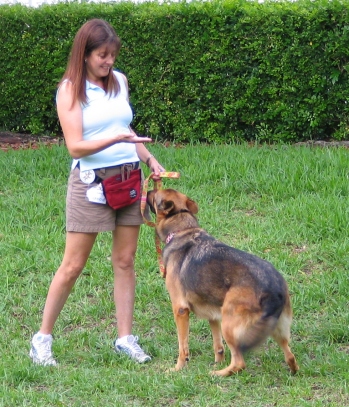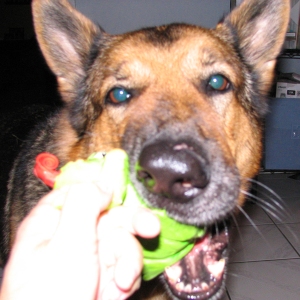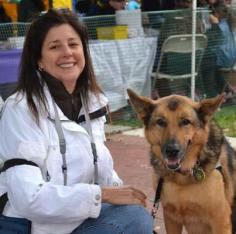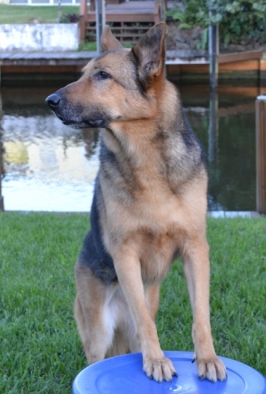Posts Tagged ‘dog behavior’
How To Handle a Bad Day
Another Walk for the Animals has come and gone. It’s a great feeling to have the support of friends and family, generously donating to a cause that I love. The weather couldn’t have been better; nice and cold so we didn’t have to worry about heat stroke. How could anything about this day be bad? Well my walk partner Maddie had more than the usual number of reactive outbursts which was frustrating and disappointing.
The day was not a total write off. We were able to sit for our pack photo without incident. I had a few conversations with friends accompanied by their dogs without any reaction. While I lamented over several reactions with small dogs and dogs running in the FunZone, we recovered with a nice walk along the river just the two of us. When we were done, we said our goodbyes to our friends without incident and called it a day rather than pushing our luck.
Ironically, when I came home, I read a Facebook post from a fellow dog trainer proclaiming she was “guilty of bad dog training”. I actually laughed out loud because I know she is an outstanding dog trainer. The reason I’m sharing my setbacks with everyone is because we all have room for improvement (even dog trainers). We all can do things better. We all have good days and bad days. The good thing about positive reinforcement training is that although your cues, markers, timing, rewards, etc. may be way off, you are not going to do anything to ruin, traumatize, or hurt your dog. My fellow dog training friend is going back to foundation work for her sport with her dog, and I will go back to some threshold work with Maddie.
People often ask me how Maddie could have possibly earned a Canine Good Citizen Award with her reactivity issues. I always smile and tell them that it only represented a thin slice of time and everything just happened to fall into place that day. So if you encounter a bad day when things fall apart, remember that it only represents a thin slice of time in your dog’s life. There will be better days. On this day, with the help of my friends and family, we raised over $1,500 for the Humane Society of Broward County. That’s a victory by any standards!
Shaping Exercises for Your Dog (and You)
Please allow me a healthy amount of geekiness for a moment. “Shaping by successive approximations involves a process of differentially rewarding some behaviors and not others.”
I introduced the Sophia Yin “box” exercise to my basic obedience students last session. Take a look at this great video demonstration of operant conditioning. In my basic obedience class we use luring with treats to get the dogs to do behaviors like sit. Using treats that dogs follow closely with their noses, makes it easy to achieve results FOR SIMPLE EXERCISES. Complex behaviors are not always well suited for luring, so my students found this frustrating and challenging.
My students were immediately challenged by having to be quiet. Other than saying yes every time the dog successfully met a criteria, the human should not be giving cues. For advanced behaviors, successful completion of the behavior is not usually immediate. So if the handler says down, but the dog takes a few minutes to put his belly on the floor, the dog may not associate the word with the behavior. For advanced behaviors, I try to get students to successfully shape the behavior and add the cue later.
My students were also frustrated by the slow process. When shaping begins, the dog is often perplexed by what is expected. After all he has been led around by a treat on the nose for weeks. This process is new. These exercises give dogs great problem solving skills and confidence. Once you have shaped a few tricks with your dogs, he will catch on. Next time the treat bag comes out, he will confidently offer new behaviors and explore novel items you bring to the session (like a box).
If you watch the video, you’ll notice that Dr. Yin keeps raising the criteria for which Zoey. The dog gets rewarded as she gets closer to the final desired result. You’ll also notice that Zoey gets a little lost in the exercise after a few tries. Dr. Yin lowers the criteria to keep Zoey engaged. Then Zoey quickly gets back on track.
The frustrating part of this video is that I suspect Zoey has already done some shaping exercises before. Most students and dogs that are new to this will take much longer to achieve the result than Dr. Yin and Zoey.
Shaping exercises are great fun for dogs because it allows them a stress free experience of problem solving. The experience is free of humans hovering over them and barking out cues repeatedly (why would anyone listen to my “say it once” advice?). This exercise is great for handlers too. No more repeating cues until the dog learns the cue is irrelevant. In addition, my human students gain some much needed patience.
Dogs wow me every day with their amazing ability to work things out. I encourage all of you to try some shaping exercises with your dogs so they can wow you. Try Dr. Yin’s box exercise this month and let me know how it goes.
Moving Out of Your Dog’s Comfort Zone
Doesn’t it feel great to take on a new and fun challenge? I know I love getting out of my comfort zone and trying something new… especially with a little support and camaraderie from friends.
Thirteen years ago, I received a black belt rank in karate. When I first stepped into the dojo, I knew no one there and had no idea what to expect. I was never athletic and I was lucky to find a a school that was incredibly supportive and encouraging even with my lack of coordination and balance. It took me ten years to work my way through the ranks. It took some discipline to go to class after some long days at Ryder and even while I was working on my MBA. All ten years were really rewarding and challenging and gave me great confidence. Karate was one of the most amazing experiences of my life because it was so completely out of my comfort zone. It made meeting each challenge just that much sweeter!
Dogs too can benefit from getting out of their comfort zones and experiencing new challenges and experiences. Getting your dog out and about and trying new skills is very enriching. Advanced, intermediate, and competitive activities provide opportunities to enhance your dog’s life. By challenging your dog, he will learn to deal with frustration – some activities and skills just aren’t a piece of cake. Face it, life isn’t a piece of cake, even for dogs. Learning how to deal with frustrating situations and getting great rewards for patience is a valuable skill in a dog’s life. Dogs also gain lots confidence from being out of their comfort zone and getting rewards and enriching experiences in return.
So what’s a dog owner to do after basic obedience? As I write this, my window is open and I am enjoying the sunny 73 degree weather. If you live in South Florida, you could not pick a better time to get out there and have some fun with your dog. In February, Oh Behave will be offering K9 Fun Nosework and an Intermediate class so you and your dog can learn some snazzy skills and benefit from spending time with your best buddy!
Mind Your Manners
 Teaching manners to puppies is pretty easy to do, yet many pup parents overlook this important step in puppy rearing. The fact is that puppies are adorable no matter what they are doing. However, many behaviors that may be cute now, are not so cute when a puppy grows to be a 75 pound monster. The way to keep your puppy from becoming that monster is to develop manners by teaching some impulse control.
Teaching manners to puppies is pretty easy to do, yet many pup parents overlook this important step in puppy rearing. The fact is that puppies are adorable no matter what they are doing. However, many behaviors that may be cute now, are not so cute when a puppy grows to be a 75 pound monster. The way to keep your puppy from becoming that monster is to develop manners by teaching some impulse control.
When I get a 4 or five month old puppy in my group class, one of the first skills that I need to teach is a gentle mouth. Some pups are completely unaware of the sensitive human fingers when gobbling down treats. I’ll close my treat hand with the treats inside and let the puppy get frustrated. He’ll bite, paw and try to bully me into releasing my hand. The pup eventually gives up and backs away. That’s when I say yes and release my hand.
There are so many areas that impulse control can be taught at an early age: greeting guests, walking on a leash, getting out of the door, getting leashed up, coming out of the crate, waiting for the food bowl and many more. Nobody wants to be knocked down by an exuberant dog during any of these activities. That’s why it’s important to teach impulse control BEFORE the dog gets big enough to knock you down.
Take a look at the video at the link below of Sammy coming out of his crate. Through several blocking techniques using the door or my arm, I prevented Sammy from barreling out of his crate. Instead, I taught him to sit and wait to be leashed. I had already introduced a stay cue with Sammy, so the exercise was pretty simple and he caught on fast.
SAMMY EXITS CRATE WITH MANNERS
Of course it’s still possible to teach manners to an unruly 75 pound dog. I do it all the time. It sometimes takes tools to give a small owner more leverage and alot of patience to undo a behavior that is ingrained. It’s oh so much easier to teach a puppy some manners from day one.
Unpredictable Rewards-Predictable Behavior
“My dog will only come if I have a treat in my hand”. I hear this complaint often from people that have taken a basic obedience course, but did not follow through with fading the lure, using variable rewards and also using non-food rewards.
During the learning phase, we reward every time the dog offers the desired behavior (continuous reinforcement). So, while we are teaching “come”, we reward him every time he offers the behavior when cued. I try to stack the deck in my favor by making the distance short and using high value rewards. Once the dog predictably offers the behavior on cue, we become unpredictable. with the rewards. We give a reward after an unpredictable amount of correct responses (variable ratio schedule of reinforcement). This produces a high and steady rate of responses. In fact, there is an entire industry out on SR 7 based on variable ratio schedules of reinforcement. We call it gambling.
I recently had a booth at an animal adoption fair. I tried to speak to as many people as possible because, the more people that interact with me, the greater the likelihood that I will gain more clients/students. So here’s the analogy. If you only treat your dog when the dog sees a treat or treat bag present, your dog will crack the code. How are you going to motivate a dog that knows he’s not going to get any reward if there is no treat in sight? It would be nice if clients were that predictable. Wouldn’t it be nice if all of the people that were going to be paying clients, had $100 bills pasted to their foreheads? Why would I spend my time speaking to anyone except the people with the $100 bills on their foreheads?
Here’s the trick… be unpredictable. Once the dog has learned a cue like “come”, put away the treat bag. Ask the dog to come in a distraction free environment, from a distance of 12 inches. When the dog offers the behavior, say “yes” (marks the behavior), then go get the dog a treat from the pantry. Then be variable. Do it again and praise him (no treat). Do it again and take him for a walk. Do it 2 more times with only praise. Do it another time and play fetch. When you use markers like a clicker and “yes”, the dog will still associate the rewards with the behavior even if a little time passes in between the two events.
Have some fun being so unpredictable that your dog won’t ever crack the code!
How Cute Is That?
So you have your new puppy and he’s soooo cute. The little guy loves to jump up to greet you, pounce on you for attention, and explore the world running on leash with amazing speed and enthusiasm! Isn’t that the cutest thing?!?!
Well, maybe it is now… but if you have a medium to large breed dog, it’s not going to be so cute in a few months. Even if you have a smaller breed dog, I can attest to the fact that doggie nails on my shins is no walk through the park.
When bringing home the new pup, your rules and the behaviors you teach should be compatible with your expectations of the dog in 5 months, 5 years, and even 10 years.
I will discuss household manners later. Before etiquette, there are a few priorities you need to address straight away with the pup. Here are the developmental deadlines according to Ian Dunbar:
The 4th Developmental Deadline
Socialization with People
The Most Urgent Priority-by 12 weeks of age
The 5th Developmental Deadline
Learning Bite Inhibition
The Most Important Priority-by 18 weeks of age
The 6th Developmental Deadline
Preventing Adolescent Problems
The Most Enjoyable Priority-by five months of age
To read more about what to do After You Get Your Puppy, you can download Dr. Dunbar’s free e-book at http://www.dogstardaily.com/files/AFTER%20You%20Get%20Your%20Puppy.pdf
Now, back to household manners. Teaching your dog a little bit of impulse control at a young age can set you up for tremendous success during adolescence and adulthood. The best part is that it does not require any formal training or skills, it just requires some impulse control from the owner.
Many pups learn to get things by bullying their way into it. Pup gets treats from your hands by pawing at and mauling your hands. Pup gets attention by barking at or jumping on you. Because it’s so cute (or you’re in pain from those pointy puppy teeth), you give in.
Rather than giving in too quickly, just wait. Wait until the pup takes a breath from chewing on your closed hand. Say yes and open your hand. Wait until the pup puts all four paws on the ground before you give any attention or affection to him. Pups pick up on this very quickly.
So please.. DO try this at home!
Reducing Background “Noise”
 Dogs are pretty smart. With the right training, they can learn countless cues and associated behaviors. They can range from simple behaviors like sit to complex behaviors like putting away toys. Occasionally, dogs have trouble understanding a cue. Typically cues are taught verbally and accompanied by a hand signal. Sometimes “background noise” contributes to the dog’s confusion. Consider the following nuances that can undermine a handler’s effectiveness.
Dogs are pretty smart. With the right training, they can learn countless cues and associated behaviors. They can range from simple behaviors like sit to complex behaviors like putting away toys. Occasionally, dogs have trouble understanding a cue. Typically cues are taught verbally and accompanied by a hand signal. Sometimes “background noise” contributes to the dog’s confusion. Consider the following nuances that can undermine a handler’s effectiveness.
*Environment: If you’ve never practiced cues outside of the training area, proofing is required. Dogs don’t easily generalize. Sometimes dogs need to be trained from the beginning if the environment changes. Using luring (food to guide the dog) or shaping (waiting for the dog to offer a behavior and marking and rewarding it) dogs can re-learn the association between the cue and the desired behavior.
*Consistency: Use the same word (verbal cue) and the same hand signal for the behavior every time.
*Verbal chatter: Dogs are not linguists and it is difficult for them to “hear” the cue sit if it is cluttered by irrelevant chit chat. Say only the cue and say it only once.
*Body language: Many of the hand signals used in basic obedience can easily be drowned by distracting body language. Fidgeting with leashes, treats, treat bags, hair, hats, etc. can be very confusing to a dog.
If your dog seems confused during training sessions, try taking a video of your session to see if you are undermining your training with background noise. Once you can see things from your dog’s perspective, you can work on making things easier for your dog.
Teaching Gentle
 Maddie has a very high prey drive and watching her chase, chew, tug, and pounce on toys is pretty entertaining. As much as she enjoys the attack and destroy play, it is also important to teach her self restraint and bite inhibition.
Maddie has a very high prey drive and watching her chase, chew, tug, and pounce on toys is pretty entertaining. As much as she enjoys the attack and destroy play, it is also important to teach her self restraint and bite inhibition.
We worked on bite inhibition with the seek & destroy toys when she came close to or had teeth on my hands and fingers. Maddie learned that any contact with hands and teeth had to be gentle or the game stopped and no more fun was had. Because of this training, it is safe for me to reach in her mouth and pull out toys, or just tell her to drop. We also worked on gentle when she took a toy from my hand. If I say gentle, she has to take the toy slowly and with gentle pressure or I will not let go.
So – meet the frog. Froggie is not as resilient as a Kong. Therefore, I had to teach Maddie to be gentle with Froggie. When we play with Froggie, we do not make Froggie look like prey. I don’t throw her or kick Froggie

Be gentle to Froggie
around the ground. Instead, we play gentle. When we pass her back and forth, we do it gently. I tell Maddie to be gentle with Froggie. So far, Froggie’s squeaker and body are still intact. We’ll see how long Froggie lasts.
For information on group classes or private training with Oh Behave, please visit www.ohbehavedogtraining.com

.jpg)

.jpg)


